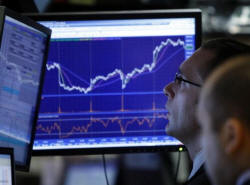|
After explosive growth,
bond ETFs brace for the next big test
 Send a link to a friend
Send a link to a friend
 [December 12, 2016]
By Simon Jessop and Sujata Rao [December 12, 2016]
By Simon Jessop and Sujata Rao
LONDON
(Reuters) - A wild ride for bond markets since the U.S. election has
re-ignited concern about a liquidity crunch in parts of the
exchange-traded funds market, home to a small but fast-growing slice of
global assets.
Despite weathering several shocks since the 2008-9 crisis, the jury is
still out on how the funds - which trade as shares and aim to replicate
the price of a basket of bonds or other assets - will react if another
cataclysm hits.
The big question for 2017 is whether the bond market flux seen after
Donald Trump won the U.S. presidential election turns into a tougher
test as interest rates rise, especially as fears grow of another
political crisis in Europe.
Concern derives in part from the industry's explosive growth in the past
three decades, to $11.3 trillion in 2015. With investors attracted by
their low fees, ETF assets will total $23.2 trillion in 2020,
consultancy PWC predicts.
Many also draw parallels with asset-backed securities. When the market
for the assets underlying those products dried up in 2008, banks holding
them were forced almost overnight to mark their value down to zero. That
led to a crisis whose fallout is being felt almost a decade on.
ETF providers say the concerns are overblown and the market actually
helps investors by setting a price for assets that may not actively
trade in the underlying market.
But Frederic Lamotte, chief investment officer at wealth manager
Indosuez, calls the ETF market "a crisis waiting to happen". While he
sometimes uses equity ETFs for tactical trades, he has banished bond
ETFs from his 110 billion-euro portfolio.

"When someone wants to sell an ETF and no one wants to buy, the price
can fall sharply when there are no fundamental issues with the
underlying assets," he said.
His concerns center on ETFs that track illiquid assets, particularly
high-yield corporate debt or that issued in emerging markets, where a
bond may not trade in size for weeks or months.
That very ability to buy and sell an illiquid asset with the ease of a
share has seen ETFs dedicated to emerging market debt grow four-fold
since 2011 to $35 billion, fund research house Morningstar estimates.
High-yield, or 'junk' bond ETFs, meanwhile, are at almost $60 billion
from $18 billion in 2011.
But these sectors and dedicated ETFs have expanded at a time of
shrinking trading volumes, as tough rule changes after the 2008 crisis
hit banks' ability to trade on their own account.
Ajith Nair, who advises institutional clients on fixed income investing
at KPMG, said the ETF model had not been tested for an extreme scenario,
where liquidity dries up.
Although they have fared well in smaller tests, including during the
2013 selloff, it is unclear how the products would react to a bigger,
more protracted shock, he said.
And if bond ETF assets in 2008 were roughly on par with what
market-making banks held on their books, ETFs today have 38 times more
bonds than banks, Lamotte notes.
DEFENSE
The fear is both that panic-selling of ETF units could spread across the
wider market and that too big a gap may open up between the value of the
ETF and its underlying assets.
[to top of second column] |

File Photo: Traders work on the floor of the New York Stock
Exchange, April 2, 2009. REUTERS/Brendan McDermid

Ordinary mutual funds can guard themselves to an extent by holding part of their
portfolio in cash, an option not available to most ETFs.
Those concerns have prompted the U.S. Securities and Exchange Commission to look
more closely at how many liquid and illiquid assets ETFs should be required to
hold.
Providers, though, point out that ETFs are a fraction of the size of cash-bond
markets, limiting contagion. The ETF structure has also proven to act as a
shock-absorber in periods of stress, they say.
The first line of defense is that, like any share, the ETF allows a range of
investors to invest at the same time, limiting large falls as value hunters move
in.
"At times of volatility in the market, we're seeing spikes in the volumes of
ETFs being traded," said Patrick Mattar, head of European broker dealer sales
and execution services at iShares, part of BlackRock <BLK.N>, the world's
biggest asset manager.
"So,
at the point where on a price basis people are really attracted to go and trade,
and trading the underlying could be tested, trading the ETF is increasingly a
very practical route for access."
The second line of defense is the ability to redeem ETF shares if the market
maker - a bank or other 'authorized seller' - thinks ETF prices have fallen too
far relative to the underlying assets.
If this happens, the market maker can hold the ETF units back until the market
recovers, matching the risk with a derivative contract.
They could also exchange units with the ETF provider for cash or the underlying
assets, which they can either sell, pass on to the end investor or hold until
prices recover.
So far, this has worked well. But KPMG's Nair warns that a complete liquidity
crunch is yet to test market makers' willingness to perform as such.
"They'd have to sell it into a market that's going down – in that worst-case
scenario, although the secondary market could still operate, these primary
market makers could evaporate."
[© 2016 Thomson Reuters. All rights
reserved.] Copyright 2016 Reuters. All rights reserved. This material may not be published,
broadcast, rewritten or redistributed.

 |